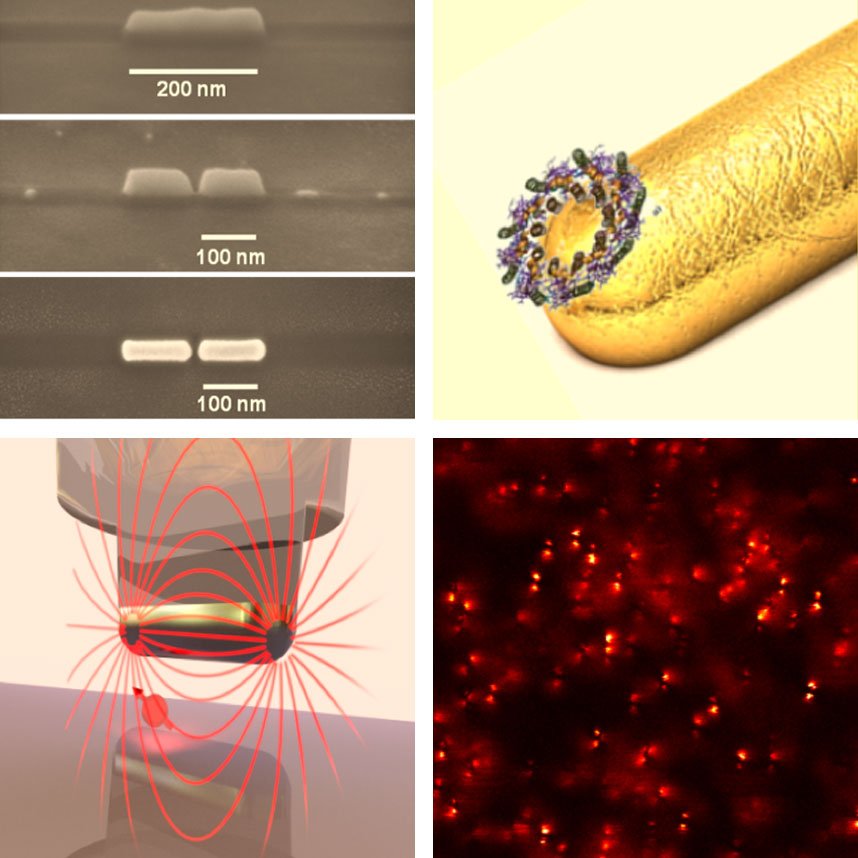Plasmonics in Biology
Plasmonics for Biology and NanoMedicineProject description
Plasmonics, Optical nanoantennas are metallic nanoparticles of 10 to 200 nm in size which find wide application in the engineering of light at nanoscale. Particularly nanoantenna do localize and enhance light fields at the nanoscale. Emitters in close proximity are driven to high emission rate in controlled directed. Both the enhanced sensitivity and resolution open a variety of applications in biology.
The group works on two approaches:
· Surface antenna arrays: tuning the antennas into resonance very efficient detection of single molecules is achieved both by enhanced excitation and quantum efficiency. Low efficiency systems such as light-harvesting complexes can be made to emit brightly.
· Scanning resonant antenna probes: resonant antennas have local enhanced hotspots with <30 nm FWHM, ideal as a scanning nano-light-source for nanoscopy of high density biosamples. Moreover the localization on sub-nm scale allows extreme resolution nanoscopy.
ICFO groups associated with the project
ICFO publications associated with the project
-
Pushing the Photon Limit: Nanoantennas Increase Maximal Photon Stream and Total Photon Number
E. Wientjes, J. Renger, R. Cogdell, and N.F. van Hulst,The Journal of Physical Chemistry Letters, vol. 7, pp. 1604-1609, 2016.
-
Fiber-Based Optical Nanoantennas for Single-Molecule Imaging and Sensing
A. Singh, J.T. Hugall, G. Calbris, and N.F. van Hulst,Journal of Lightwave Technology, vol. 33, pp. 2371-2377, 2015.
-
Matching Nanoantenna Field Confinement to FRET Distances Enhances Förster Energy Transfer Rates
P. Ghenuche, M. Mivelle, J. de Torres, S.B. Moparthi, H. Rigneault, N.F. Van Hulst, M.F. García-Parajó, and J. Wenger,Nano Letters, vol. 15, pp. 6193-6201, 2015.
-
Nanophotonic boost of intermolecular energy transfer
P.M. de Roque, N.F.V. Hulst, and R. Sapienza,New Journal of Physics, vol. 17, pp. 113052, 2015.
-
Nanoantenna enhanced emission of light-harvesting complex 2: the role of resonance, polarization, and radiative and non-radiative rates
E. Wientjes, J. Renger, A.G. Curto, R. Cogdell, and N.F. van Hulst,Phys. Chem. Chem. Phys., vol. 16, pp. 24739-24746, 2014.
-
Strong antenna-enhanced fluorescence of a single light-harvesting complex shows photon antibunching
E. Wientjes, J. Renger, A.G. Curto, R. Cogdell, and N.F. van Hulst,Nature Communications, vol. 5, 2014.
-
Vectorial Nanoscale Mapping of Optical Antenna Fields by Single Molecule Dipoles
A. Singh, G. Calbris, and N.F. van Hulst,Nano Letters, vol. 14, pp. 4715-4723, 2014.
-
Multipolar Interference for Directed Light Emission
I.M. Hancu, A.G. Curto, M. Castro-López, M. Kuttge, and N.F. van Hulst,Nano Letters, vol. 14, pp. 166-171, 2013.
-
A Resonant Scanning Dipole-Antenna Probe for Enhanced Nanoscale Imaging
L. Neumann, J. van ’t Oever, and N.F. van Hulst,Nano Letters, vol. 13, pp. 5070-5074, 2013.
-
A plasmonic ‘antenna-in-box’ platform for enhanced single-molecule analysis at micromolar concentrations
D. Punj, M. Mivelle, S.B. Moparthi, T.S. van Zanten, H. Rigneault, N.F. van Hulst, M.F. García-Parajó, and J. Wenger,Nature Nanotechnology, vol. 8, pp. 512-516, 2013.
-
Multipolar radiation of quantum emitters with nanowire optical antennas
A.G. Curto, T.H. Taminiau, G. Volpe, M.P. Kreuzer, R. Quidant, and N.F. van Hulst,Nature Communications, vol. 4, 2013.
-
Ultrabright Bowtie Nanoaperture Antenna Probes Studied by Single Molecule Fluorescence
M. Mivelle, T.S. van Zanten, L. Neumann, N.F. van Hulst, and M.F. Garcia-Parajo,Nano Letters, vol. 12, pp. 5972-5978, 2012.
External collaborations
Richard Cogdell, University of Glasgow, UK. C. Neil Hunter FRS, Dept. MolecBio & Biotec, Univ. of Sheffield, UK . Jerome Wenger, Hervé Rigneault, Institut Fresnel, Marseille, France. Benedetta Menucci, University of Pisa, Italy. Lukas Novotny, Nano-Optics, ETH Zurich, Switzerland. Reuven Gordon, University of Victoria, British Columbia, Canada. Henkjan Gersen, Dept. Phys., University of Bristol, UK. Iwan Moreels, Italian Institute of Technology (IIT), Genova, Italy. Fernando Stefani, University of Buenos Aires, Argentina. Klaus Müllen, Max Planck Inst. Polymer research, Mainz, Germany
Funding
ERC-Adv.Grant-2014 – n° 670949 LightNet, ERC Adv. Grant 2009 – n° 247330 NanoAntennas), EC 7th Framework Programme project NanoVista (no. 288263), ESF – Research Network Program Plasmon-BioNanosense, MINECO QUACO FIS2012-35527 and FIS2014-55563-REDC, AGAUR SGR 1540, Laser Lab Europe (no. 284464), Fundacio Privada CELLEX Barcelona

